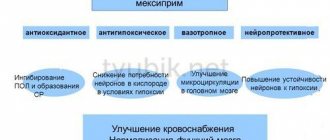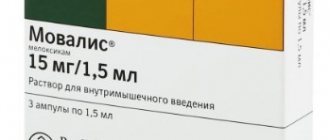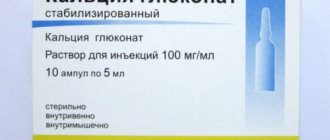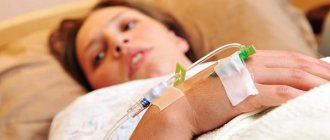Pharmacodynamics and pharmacokinetics
Pharmacodynamics
Tetanus serum contains immunoglobulins from the blood serum of horses immunized with tetanus toxin . The whey is purified and concentrated by peptic digestion. Specific antibodies neutralize tetanus toxin . The use of antitetanus serum (of varying activity) is indicated for the prevention of tetanus and in the treatment of the disease.
Pharmacokinetics
Data not provided.
What do PSCHI and PSS vaccines contain?
For emergency vaccination to prevent infection, two types of drugs are used - PSCHI and PSS; you should find out what the difference is between them:
- PSCH . The PSCH vaccine is a homologous human tetanus immunoglobulin and is in the form of a solution. This serum contains the gamma globulin fraction of donor blood obtained from people who have undergone immunization with tetanus toxoid. One dose of the PSCHI vaccine containing 250 IU of the substance allows you to provide the appropriate protective level of toxoid for three weeks;
- PSS . It is a liquid concentrated anti-tetanus serum, which is obtained from the protein fraction of horse blood serum containing specific immunoglobulins. Horses are pre-hyperimmunized with tetanus toxoid or toxin. Peptic digestion is used to purify and concentrate whey. This product is presented in the form of a clear liquid, colorless or having a light yellowish tint. Slight opalescence is acceptable.
Antitetanus serum, instructions for use (Method and dosage)
For emergency prevention of tetanus, antitetanus serum is administered subcutaneously at a dose of 3000 IU. This dose is administered to adults and children as soon as possible after injury and up to 20 days after injury. Before introducing the serum, a test is carried out with diluted serum: intradermally in the forearm in an amount of 0.1 ml and after 20 minutes the reaction is recorded. If the diameter of the redness is less than 1 cm, the test is negative, if 1 cm or more, the test is positive.
If the test is negative, the serum is injected subcutaneously into the outer surface of the shoulder or subscapular region, first in an amount of 0.1 ml, and then the entire dose if there is no reaction. If the test is positive, serum administration is contraindicated. In this case, ICHPS ( human immunoglobulin ) is administered.
When treating tetanus, 10,000–20,000 IU is administered intravenously or into the spinal canal as early as possible. the seizures disappear . The drug can be used to treat tetanus in children from the first days of life. The dosage depends on the condition of the sick child.
Before administering the serum (in any case), antishock therapy is prepared. Given the possibility of shock developing after using the serum, the patient must be monitored for 1-2 hours. Do not use the drug if the integrity of the ampoules is damaged, there is no labeling, or if there is a change in color or transparency.
Technique for administering anti-botulinum serum
ADMINISTRATION OF SERUM USING THE BEZREDKO METHOD
Algorithm:
1. Before administration to the patient, ampoules with serum are carefully examined. Serums that are cloudy or with unbreakable sediment and foreign impurities, in damaged ampoules or with no label on them are unsuitable for use.
2. before administration, the serum is heated to 37°C in a water bath;
3. The end of the ampoule is wiped with sterile cotton wool moistened with alcohol and cut with a special knife, after which the upper part of the ampoule is wiped with alcohol and broken off;
4. cover the opened ampoule with a sterile napkin and cotton wool;
5. the introduction of medicinal serums is carried out under the supervision of a doctor;
6. to prevent anaphylactic shock, the method of fractional administration of heterogeneous serums according to A.I. is used. Frequently. Before administering a therapeutic dose of serum, the body's sensitivity to foreign protein is determined using an intravenous test. An intravenous test is carried out with a serum diluted 100 times, which is placed in each box (ampoules are marked in red) along with the therapeutic serum (ampoules are marked in blue);
7. in the middle part of the palmar surface of the forearm, after disinfection of the skin, a thin needle of a tuberculin syringe is injected into the thickness of the skin parallel to its surface;
8. After the section of the needle facing upward has entered the skin, 0.1 ml of diluted serum is injected from the ampoule marked in red. When administered correctly, a “lemon peel” and a small, dense nodule will form on the skin.
9. 0.1 ml of saline solution is injected intravenously into the forearm of the second arm as a control;
10. Observe the reaction for 20-30 minutes. If the diameter of the papule formed at the injection site does not exceed 0.9 cm, and the hyperemia around it is small, the test is considered negative.
11. then 0.1 ml of whole serum from an ampoule marked in blue is injected subcutaneously (into the area of the middle third of the outer surface of the shoulder);
12. in the absence of a general reaction to this dose, after 30 minutes, inject the prescribed dose of serum intramuscularly into the outer upper quadrant of the gluteal muscle;
13. If the reaction to intravenous injection is positive, the serum is administered at the discretion of the doctor.
14. If the reaction is positive
, the therapeutic serum is administered only for health reasons in the presence of a doctor and with full readiness for emergency treatment in the event of anaphylactic shock; in this case, it is recommended to administer the serum, diluted 100 times, subcutaneously in doses of 0.5 ml, 2 and 5 ml with intervals between injections of 20 minutes. If the reaction to the indicated doses of diluted serum is negative, administer 0.1 ml of undiluted serum, and after 30 minutes - the entire remaining dose.
Each administration of the serum must be registered in the medical history with the obligatory indication of the dose, method and time of administration, batch number, expiration date, and the name of the institute that produced the serum.
The maximum volume of serum injected into one area should not exceed 10 ml.
After administration of the serum, patients should be under medical supervision for 1 hour.
No. 2. Treatment of patients with viral and bacterial infections: infectious mononucleosis, influenza, ARVI, diphtheria, meningococcal infection.
Collection of complaints, medical history, life history, epidemiological history.
COMPLAINTS
Complaints are inherently a subjective manifestation of the disease. During the initial examination, it is advisable to give the patient the opportunity to present them freely. In none of the infections do patients present any complaints that could be considered pathognomonic. Similar complaints are recorded in patients with various infectious and, to a large extent, non-infectious diseases. At the same time, the analysis of patient complaints is highly informative for a trained student. In this case, the indispensable conditions for success are: targeted detailing of the patient’s complaints, identifying the leading complaints, taking into account their combinations and, of course, knowledge of the features of the disease picture in various infections. When describing complaints systematically, the student must be able to identify the main and the secondary. It makes more sense to first present complaints that characterize the disease as infectious. In this case, it is practically more convenient to use a conditional division of diseases into groups: infections with general toxic syndrome, with damage to the central nervous system, acute intestinal infections, respiratory tract infections, infections with damage to the skin and mucous membranes.

With infections with general toxic syndrome, patients usually complain of headache, general weakness, fatigue, muscle pain, and sleep disturbances. It is important, if possible, to assess the intensity of these complaints. Thus, a mild headache is recorded with a variety of infections. At the same time, a pronounced headache suggests a neuroinfection or typhus. It is also important to clarify the nature of the headache. Important facts are not only the increase in temperature, but also its daily fluctuations, the duration of the fever, the presence of chills, sweats, and the reaction to an antipyretic drug. Repeated vomiting of cerebral origin, which does not bring relief, and general hyperesthesia deserve great attention. If there are complaints of arthralgia and myalgia, their primary location is specified. Complaints of general toxic origin can occur with any infection, as a manifestation of the syndrome of general infectious intoxication.
Complaints of upset stool, abdominal pain, nausea, and vomiting characterize a group of infectious diseases with a predominant lesion of the gastrointestinal tract (acute intestinal infections). The leading complaint of patients is the appearance of frequent loose stools. It is important to clarify the frequency, volume of bowel movements, the nature of the urge, the degree of liquefaction (watery, liquid, mushy) and the color of the feces, the presence of impurities (lumps of mucus, streaks of blood). It is important to find out the presence of nausea, vomiting, time of occurrence, nature of the vomit, frequency, combination of diarrhea with vomiting. It is also necessary to detail the nature and primary localization of abdominal pain, the presence of tenesmus, false urges, spasm and tenderness of the sigmoid colon.
Nasal congestion, runny nose, sore throat, sore throat, sore throat, cough, etc. are signs of infections affecting the respiratory tract and lungs. Additional questioning of patients is necessary to clarify their characteristics. The cough can be dry (unproductive) and wet (productive with sputum production), moderate intensity, paroxysmal, turning into suffocation, convulsive (with whooping cough). Sputum can be released in different quantities, mucous and purulent, without admixture and with blood. Runny nose - with scanty or profuse discharge, serous, mucous or mucopurulent, sanguineous. Sore throat, clarification of its intensity.
In some infections, in addition to the general toxic syndrome, complaints indicating the development of organ pathology are also detected. These include, in particular, complaints of decreased urination, thirst, and polyuria.
Patients with viral hepatitis are admitted, as a rule, after the appearance of jaundice. The leading complaints are icteric staining of the sclera and skin, darkening of urine (choluria), lightening of stool (acholia). Clarification of the sequence of these manifestations, the presence of pain in the right hypochondrium, severe itching of the skin are of important diagnostic value. It is important to clarify the presence and nature of the pre-icteric period. Patients with infectious diseases
Predominantly affecting the skin and mucous membranes, people usually complain of rashes of various types. Complaints of a burning sensation, skin tension, itching, moderate pain in certain areas of the skin and mucous membranes, which soon reveal objective changes.
HISTORY OF THE DISEASE
The medical history includes a detailed history of the present illness. Through a survey, it is necessary to identify in chronological order the development of all subjective and objective manifestations of the disease; this is one of the main components of collecting an anamnesis of the disease. Similarly, the dynamics of objective manifestations of the disease, especially fever, are taken into account. Particular attention is paid to the cyclical nature of the disease, which is typical for infectious pathology.
It is diagnostically important to identify the first signs of this nosological form of the infectious disease, i.e. initial period of the disease (early diagnosis). In many infectious diseases, the onset is acute with rapid progression of the main clinical symptoms. With such infections, the initial period is calculated in hours. In these cases, usually patients can even indicate the hours of onset of the illness. In others, it lasts from 3 to 9 days or more. The time of development of an infectious disease in cases of acute onset, lightning-fast course is counted in hours, in other cases with gradual development it is noted by days of illness. It is necessary to strive to identify and group syndromes that characterize an infectious disease: general infectious, diarrheal, with damage to the nervous system, respiratory system, exanthema, jaundice, etc. It is necessary to find out the patient’s treatment before hospitalization, to clarify what drugs he took, since many of them (antibiotics, sulfonamides, etc.) can change the clinical course of the disease.
The results of clinical, instrumental, laboratory and other studies performed before the patient’s admission to a medical institution must be reflected in the medical history. Finding out the medical history should be leisurely, thoughtful, comprehensive, with the participation of the patient himself and taking into account his psychological characteristics, character, intelligence, and upbringing.
Reviews of Antitetanus Serum
Tetanus is a serious infection that occurs with damage to the nervous system, which is manifested by cramps of skeletal muscles, possible development of suffocation and death. That is why, according to the plan, children are given active tetanus prophylaxis with DTP , ADS , ADS-M . The first complex vaccination is given to babies in the maternity hospital, and then revaccination is carried out. If you have received a full course of vaccinations, anti-tetanus serum is not administered for simple wounds.
Passive prevention for injuries is carried out with PSS (anti-tetanus serum) or IP PS , which is preferable for children. Prevention of the disease is very important because a person is susceptible to tetanus bacillus .
The pathogen spores enter through a wound, cut, or burn surface and begin to produce a toxin . The clinical picture of the disease sometimes occurs after the wound has healed. PSS is administered as early as possible . For severe open injuries, the drug is administered from the 3rd day of injury and no later than the 12th day. If a person is not vaccinated or there is no information about vaccinations, then in the case of grass, he is given active-passive prophylaxis - toxoid and serum are administered. There are often reviews and they are associated with the presence of adverse reactions.
- “... My husband was injected with serum - his arm at the injection site hurt for a month.”
- “... Anatoxin is easier for the body, but serum was more difficult for the body.”
- “... They gave me this serum - I pierced my leg with a rusty nail. I think it’s better to play it safe, since the side effects are nonsense compared to tetanus.”
- “... I had an allergic reaction after the injection - I began to shake, my temperature rose, the pain at the injection site was hellish and it was difficult to breathe. I was hospitalized."
- “... It would be better if we vaccinated the child, since tetanus serum is less tolerated than vaccination.”
- “... The serum is very allergenic and the child was under the supervision of doctors for 2 hours after it. Everything worked out for us."
- “... The thing is not harmless, so I refused, but the wound was received at home, was not contaminated and was open.”
Mechanism of action

It must be administered as soon as possible from the moment the first signs of the disease appear or after injury to the skin.
First, primary treatment of the skin lesion is performed and the degree of sensitivity of the body to the foreign protein is determined. This is done using an intradermal test, which gives results after 20 minutes.
If the test is negative, the full dosage of PSS serum can be administered. If the test is positive, only PSCH is allowed to be administered.
Reaction and side effects
In some cases, especially due to individual intolerance to the serum, the following reactions are possible:

- redness of the skin at the site of vaccine administration;
- itching and discomfort;
- slight malaise and feeling of weakness;
- nausea and vomiting;
- within a few hours from the moment of vaccination - increase in body temperature;
- convulsive spasms of the muscles of the limbs.
Side effects are also possible in the form of:
- cough and feeling of dry mouth;
- rhinitis;
- inflammation of the lymph nodes;
- fever;
- pain in the joints.
If these symptoms appear, you should visit a doctor.
Indications for vaccination
Vaccination is carried out when the very first signs of tetanus infection appear.
The following symptoms may indicate the beginning development of the disease:

- convulsive contraction of the masticatory muscles, making it almost impossible to open the mouth;
- difficulty swallowing caused by convulsive muscle spasms;
- prolonged involuntary contraction of the facial muscles, leading to a painful facial expression resembling a grin;
- excessive increase in the tone of the occipital muscles.
Emergency immunoprophylaxis using antitetanus serum is prescribed by an infectious disease doctor.
The main indications for emergency immunoprophylaxis are:
- wounds, trauma and other types of damage to the skin, mucous membranes and tissues;
- frostbite of tissues, as well as thermal and chemical burns, starting from the second degree of severity;
- births or abortions performed outside of health care facilities;
- the presence of abscesses that last too long;
- animal bites;
- tissue necrosis or gangrene;
- penetrating damage to the gastrointestinal tract.

Equine antitetanus serum
Compatibility with alcohol and drugs
After administration of tetanus serum, it is prohibited to drink alcoholic beverages for three days.

Otherwise, adverse reactions may develop:
- temperature increase;
- allergic skin rashes;
- intestinal dysbiosis and diarrhea;
- exacerbation of chronic diseases.
It should also be taken into account that the combined administration of serum and tetanus toxoid leads to suppression of the immune response.






